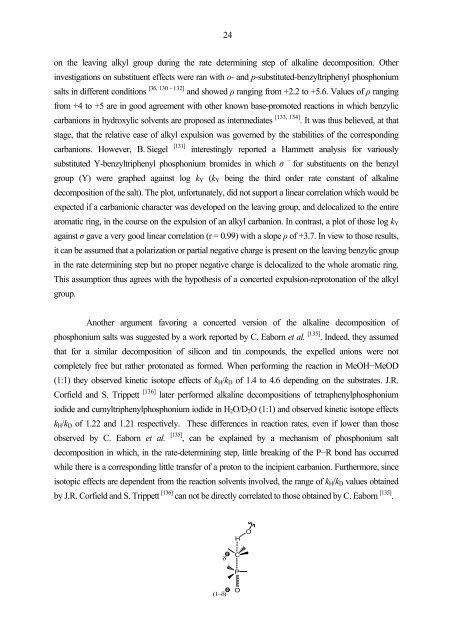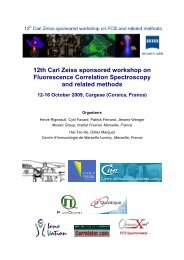My PhD dissertation - Institut Fresnel
My PhD dissertation - Institut Fresnel
My PhD dissertation - Institut Fresnel
Create successful ePaper yourself
Turn your PDF publications into a flip-book with our unique Google optimized e-Paper software.
24<br />
on the leaving alkyl group during the rate determining step of alkaline decomposition. Other<br />
investigations on substituent effects were ran with o- and p-substituted-benzyltriphenyl phosphonium<br />
salts in different conditions<br />
[36, - ] 130 132 and showed ρ ranging from +2.2 to +5.6. Values of ρ ranging<br />
from +4 to +5 are in good agreement with other known base-promoted reactions in which benzylic<br />
carbanions in hydroxylic solvents are proposed as intermediates<br />
[ , ] 133 134 . It was thus believed, at that<br />
stage, that the relative ease of alkyl expulsion was governed by the stabilities of the corresponding<br />
carbanions. However, B. Siegel [131] interestingly reported a Hammett analysis for variously<br />
substituted Y-benzyltriphenyl phosphonium bromides in which σ – for substituents on the benzyl<br />
group (Y) were graphed against log kY (kY being the third order rate constant of alkaline<br />
decomposition of the salt). The plot, unfortunately, did not support a linear correlation which would be<br />
expected if a carbanionic character was developed on the leaving group, and delocalized to the entire<br />
aromatic ring, in the course on the expulsion of an alkyl carbanion. In contrast, a plot of those log kY<br />
against σ gave a very good linear correlation (r = 0.99) with a slope ρ of +3.7. In view to those results,<br />
it can be assumed that a polarization or partial negative charge is present on the leaving benzylic group<br />
in the rate determining step but no proper negative charge is delocalized to the whole aromatic ring.<br />
This assumption thus agrees with the hypothesis of a concerted expulsion-reprotonation of the alkyl<br />
group.<br />
Another argument favoring a concerted version of the alkaline decomposition of<br />
phosphonium salts was suggested by a work reported by C. Eaborn et al.<br />
[ ] 135 . Indeed, they assumed<br />
that for a similar decomposition of silicon and tin compounds, the expelled anions were not<br />
completely free but rather protonated as formed. When performing the reaction in MeOH−MeOD<br />
(1:1) they observed kinetic isotope effects of kH/kD of 1.4 to 4.6 depending on the substrates. J.R.<br />
Corfield and S. Trippett<br />
[ ] 136 later performed alkaline decompositions of tetraphenylphosphonium<br />
iodide and cumyltriphenylphosphonium iodide in H2O/D2O (1:1) and observed kinetic isotope effects<br />
kH/kD of 1.22 and 1.21 respectively. These differences in reaction rates, even if lower than those<br />
observed by C. Eaborn et al. [135] , can be explained by a mechanism of phosphonium salt<br />
decomposition in which, in the rate-determining step, little breaking of the P−R bond has occurred<br />
while there is a corresponding little transfer of a proton to the incipient carbanion. Furthermore, since<br />
isotopic effects are dependent from the reaction solvents involved, the range of kH/kD values obtained<br />
by J.R. Corfield and S. Trippett [136] can not be directly correlated to those obtained by C. Eaborn [135] .<br />
δ<br />
(1−δ)<br />
H<br />
C<br />
P<br />
O<br />
O













